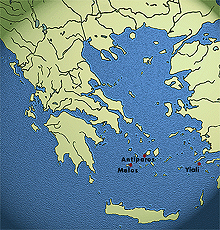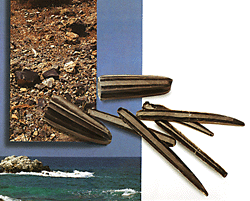 |
 Obsidian is a natural black glass which originates exclusively from geologically young volcanic regions. The obsidian sources in the eastern Mediterranean are rare and have been traced on certain islands of the Aegean: Melos (sites Sta Nychia and Demenegaki), Antiparos, Nisyros and Yiali. |

Due to its composition and resistance, this material was already being used by the end of the Upper Palaeolithic (9th millenium BC) to produce blades with sharp edges to serve as knives, scrapers and razors. The Melian obsidian was mostly used by the inhabitants of the Aegean for producing tools and weapons (arrowheads) during the Stone and Bronze Age (3200-1050 BC) because of its hardness. In contrast, obsidian from Yiali was more fragile, thus inappropriate for refine retouch and for this reason it was particularly used during the Late Bronze Age to carve stone vases. At certain settlements of the Greek area, tools and vessels made of obsidian from the Lipari Islands in Italy, from the southeast Balkans and from Ciftlik in Turkey have been unearthed. Locating tools of Melian obsidian in habitation levels of the Upper Palaeolithic at Franchthi Cave in Hermionid has provided evidence that navigation in the Aegean had already begun by the 9th millenium BC. The extraction and the transportation of obsidian at the end of the Palaeolithic and during most of the Neolithic Period (ca. 6800-3200 BC) was not carried out by populations permanently settled close to the quarries of Melos, but by more specialized groups who reached the island from settlements of central and south Aegean. According to a prevailing view based on the study of obsidian artefacts (cores, flakes and tools) from archaeological sites of central and southern Greece, after extraction a preliminary and on the spot retouch of the raw material followed at least during the Early and Middle Neolithic (ca. 6800-5300 BC). During the Late and the Final Neolithic (ca. 5300-3200 BC), when the systematic habitation of the Cyclades developed, the transportation of obsidian changed and was incorporated in the gradually developing trade networks of the Aegean. Obsidian reached then other settlements, outside Cyclades, in the form of roughly retouched cores.
|
 |
 |
 |
 |
 |
 |